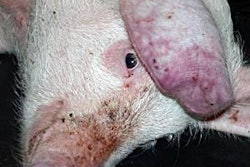By 2014, the Canadian pork industry should be “right sized.”This is the hope of the producers’ association the Canadian Pork Council (CPC), which published a Strategic Transition Plan last year and hopes to see the industry enter into a much more positive period once the plan has been implemented.
According to the CPC, hog production practices and productivity improvements, as well as exports of live animals and pork meat, have been a Canadian success story. The last few years, however, tell a different story.
Mario Lapierre, of genetics company Genetiporc, speaking at the London Swine Conference last year, said that producer margins had been negative for the previous three years, and that the crisis was not restricted to producers – processors had suffered the same negative margins for the same period.
Various factors have combined to the detriment of Canada’s producers. Health challenges, including circo-virus and H1N1, the strength of the Canadian dollar, rising feed costs, a poor global economic climate and restrictive practices by overseas customers have all taken their toll on the Canadian industry. On launching its transition plan, the CPC described the industry as “unprofitable, highly leveraged with debt and facing the prospects of imminent catastrophic implosion”.
Managed transition
The CPC is looking to 2014 in terms of managing the industry’s transition. It warns, however, that over this period there will be “a significant amount of pain for farmers, their employees, their customers and suppliers”.
However, once this transition is complete, the home market should absorb 730,000 tonnes of home-produced pork, an increase of 150,000 tonnes from 2008. The organisation hopes that this will be achieved partly through import substitution, but also through increasing total national consumption. This would result in a domestic market share for the country’s producers of 88%, up from 75% in 2008.
However, alongside this increase, there is a planned decrease in the number of pigs slaughtered. Slaughterings are planned to fall by 0.2 million to 21.5 million over the period.
By 2014, exports are hoped to stand at 1 million tonnes and, of this total, only 20% will be destined for the US.
Once these changes are in place, the industry should be set for a period of new growth and higher margins, but to be successful, the CPC says, the right financial supports must be provided by the federal government.
In August last year, the government adopted a restructuring program, including the creation of a loss reserve fund, a marketing fund and a transition program to help producers leave the industry.
Areas of focus
To help put the Canadian industry onto a more successful track, the CPC is focusing on a number of areas. The body argues that the industry needs to be more competitive. Not only does the sector need to reduce costs, but also must execute a differentiation strategy that will achieve higher margins in its chosen markets.
Between 2009 and 2014, the CPC will be focusing on the priorities of the Canadian Swine Health Board; benchmarking, a comparative regulatory review, a competitiveness strategy and a CPC Competitiveness Forum.
The CPC will also be examining market penetration. It is aiming for a decreased reliance on the US market. High value markets, including Japan, Korea, Australia, and, pending the EU/Canada trade discussions, European countries, should be the primary focus. These countries offer Canadian producers the potential to execute differentiation strategies that will deliver higher margins.
The pork industry will also pilot a trichinae certification program over 2009/2010, prior to its full implementation. This has been designed to facilitate the export of high value fresh pork to key international markets.
Quality
Raising domestic consumption will also be a key objective. The CPC will work with partners to create a “destination product”, one that increases the market share of pork against other products as well as increasing the Canadian share of pork products sold in Canada.
A national promotion strategy will be developed and implemented and this could be funded if an import levy were instituted, similar to the US system. As part of the initiative, the CPC will work with processors and key retailers to understand how they can meet the needs of Canada’s pork purchasers.
The Canadian Quality Assurance scheme is also being reviewed. The CPC has said that it will increased pariticipation to all farms that move animals directly to federally licensed plants. The Animal Care Code of Practice is also being reviewed and is due for completion by 2012.
The CPC and its members are also in the process of developing an identification and traceability system for the hog sector that will allow the industry to provide information on Canadian swine premises and trace back and forward live hog movements. Traceability is anticipated to pay future dividends in terms of boosting preparedness in the case of animal disease outbreaks, an ensuring continued market access for Canadian pork.
Alongside these initiatives, the National Swine Science Cluster is being established. Its remit will be to look at ways of increasing productivity and driving down costs, and to develop ways in which the industry can differentiate both on the home and overseas markets.


















